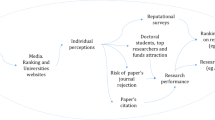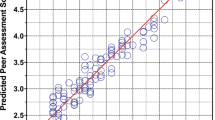Abstract
Despite ongoing debates about their uses and validity, university rankings are a popular means to compare institutions within a country and around the world. Anchoring theory suggests that these rankings may influence assessments of institutional reputation, and this effect may be particularly strong when a new rankings system is introduced. We test this possibility by examining data from the first 3 years of the Times Higher Education Supplement (THES) world university rankings. Consistent with an anchoring hypothesis, the initial THES rankings influenced peer assessments of reputation in subsequent surveys, but second-year rankings were not related to changes in reputation in the third year. Furthermore, as expected, early peer assessment ratings were not associated with changes in future rankings. These findings provide strong evidence for an anchoring effect on assessments of institutional reputation. We discuss the usefulness of these peer assessments, along with ways in which reputational surveys can be improved.




Similar content being viewed by others
References
Bastedo, M. N., & Bowman, N. A. (2010). The U.S. News and World Report college rankings: Modeling institutional effects on organizational reputation. American Journal of Education, 116, 163–184.
Bastedo, M. N., & Bowman, N. A. (in press). College rankings as an interorganizational dependency: Establishing the foundation for strategic and institutional accounts. Research in Higher Education.
Bentler, P. M., & Bonett, D. G. (1980). Significance tests and goodness of fit in the analysis of covariance structures. Psychological Bulletin, 88, 588–606.
Bollen, K. A. (1989). Structural equation models with latent variables. New York: Wiley.
Bowden, R. (2000). Fantasy higher education: University and college league tables. Quality in Higher Education, 6(1), 41–60.
Bowman, N. A., & Bastedo, M. N. (2009). Getting on the front page: Organizational reputation, status signals, and the impact of U.S. News and World Report on student decisions. Research in Higher Education, 50, 415–436.
Byrne, B. M. (2006). Structural equation modeling with EQS: Basic concepts, applications, and programming (2nd ed.). Mahwah, NJ: Lawrence Erlbaum.
Chapman, G. B., & Bornstein, B. H. (1996). The more you ask for, the more you get: Anchoring in personal injury verdicts. Applied Cognitive Psychology, 10, 519–540.
Crabbe, N. (2009, June 17). On survey, Machen rates UF with Harvard, other Fla. schools low. The Gainesville Sun. Retrieved April 2, 2010, from http://bit.ly/y9AAb.
Cremonini, L., Westerheijden, D., & Enders, J. (2008). Disseminating the right information to the right audience: Cultural determinants in the use (and misuse) of rankings. Higher Education, 55, 373–385.
Davis, H. L., Hoch, S. J., & Ragsdale, E. K. E. (1986). An anchoring and adjustment model of spousal predictions. Journal of Consumer Research, 13, 25–37.
Dill, D. D., & Soo, M. (2005). Academic quality, league tables, and public policy: A cross- national analysis of university ranking systems. Higher Education, 49(4), 495–533.
Ehrenberg, R. G. (2003). Reaching for the brass ring: The U.S. News & World Report rankings and competition. Review of Higher Education, 26, 145–162.
Elsbach, K. D., & Kramer, R. (1996). Members’ responses to organizational identity threats: Encountering and countering the Business Week rankings. Administrative Science Quarterly, 41, 442–476.
Englich, B. (2006). Blind or biased? Justitia’s susceptibility to anchoring effects in the courtroom based on give numerical representations. Law & Policy, 28, 497–514.
Englich, B. (2008). When knowledge matters—differential effects of available knowledge in standard and basic anchoring tasks. European Journal of Social Psychology, 38, 896–904.
Englich, B., & Mussweiler, T. (2001). Sentencing under uncertainty: Anchoring effects in the court room. Journal of Applied Social Psychology, 31, 1535–1551.
Englich, B., Mussweiler, T., & Strack, F. (2006). Playing dice with criminal sentences: The influence of irrelevant anchors on experts’ judicial decision making. Personality and Social Psychology Bulletin, 32, 188–200.
Espeland, W. N., & Sauder, M. (2007). Rankings and reactivity: How public measures recreate social worlds. American Journal of Sociology, 113, 1–40.
Gottlieb, B. (1999, September 1). Cooking the school books: How U.S. News cheats in picking its “best American colleges.” Slate. Retrieved November 19, 2009, from http://www.slate.com/id/34027/.
Griffith, A., & Rask, K. (2007). The influence of the U.S. News and World Report collegiate rankings on the matriculation decisions of high-ability students: 1995–2004. Economics of Education Review, 26, 244–255.
Hazelkorn, E. (2007). The impact of league tables and ranking system on higher education decision making. Higher Education Management and Policy, 19, 1–24.
Hazelkorn, E. (2008). Learning to live with league tables and ranking: The experience of institutional leaders. Higher Education Policy, 21, 193–215.
Hu, L. T., & Bentler, P. M. (1999). Cutoff criteria for fit indices in covariance structure analysis: Conventional criteria versus new alternatives. Structural Equation Modeling, 6, 1–55.
Institute for Higher Education Policy (IHEP). (2007). College and university ranking systems: Global perspectives and American challenges. Washington, DC: Author.
Janiszewski, C., & Uy, D. (2008). Precision of the anchor influences the amount of adjustment. Psychological Science, 19, 121–127.
Joyce, E., & Biddle, G. (1981). Anchoring and adjustment in probabilistic inference in auditing. Journal of Accounting Research, 19, 120–145.
Kline, R. B. (2005). Principles and practice of structural equation modeling (2nd ed.). New York: Guilford Press.
Kroth, A., & Daniel, H.-D. (2008). International university rankings: A critical review of the methodology. Zeitschrift fur Erziehungswissenschaft, 11, 542–558.
Lee, S. (2009, August 19). Reputation without rigor. Inside Higher Ed. Retrieved April 2, 2010, from http://www.insidehighered.com/news/2009/08/19/rankings.
Marginson, S. (2007). Global university rankings: Implications in general and for Australia. Journal of Higher Education Policy and Management, 29, 131–142.
McDonough, P. M., Antonio, A. L., Walpole, M., & Perez, L. X. (1998). College rankings: Democratized college knowledge for whom? Research in Higher Education, 39, 513–537.
Meredith, M. (2004). Why do universities compete in the rankings game? An empirical analysis of the effects of the U.S. News and World Report college rankings. Research in Higher Education, 45, 443–461.
Monks, J., & Ehrenberg, R. G. (1999). The impact of U.S. News & World Report college rankings on admissions outcomes and pricing policies at selective private institutions (Working Paper #7227). Washington, DC: National Bureau of Economic Research.
Mussweiler, T. (2001). The durability of anchoring effects. European Journal of Social Psychology, 31, 499–509.
Mussweiler, T., & Strack, F. (1999). Comparing is believing: A selective accessibility model of judgmental anchoring. In W. Stroebe & M. Hewstone (Eds.), European review of social psychology (Vol. 10, pp. 135–167). Chichester, UK: Wiley.
Mussweiler, T., & Strack, F. (2000). The use of category and exemplar knowledge in the solution of anchoring tasks. Journal of Personality and Social Psychology, 78, 1038–1052.
Mussweiler, T., Strack, F., & Pfeiffer, T. (2000). Overcoming the inevitable anchoring effect: Considering the opposite compensates for selective accessibility. Personality and Social Psychology Bulletin, 26, 1142–1150.
Northcraft, G. B., & Neale, M. A. (1987). Experts, amateurs, and real estate: An anchoring-and-adjustment perspective on property pricing decisions. Organizational Behavior and Human Decision Processes, 39, 84–97.
Pedhazur, E. J. (1997). Multiple regression in behavioral research: Explanation and prediction (3rd ed.). New York: Wadsworth.
Podolny, J. M. (1993). A status-based model of market competition. American Journal of Sociology, 98, 829–872.
Salmi, J., & Saroyan, A. (2007). League tables as policy instruments: Uses and misuses. Higher Education Management and Policy, 19, 1–39.
Sauder, M., & Espeland, W. N. (2009). The discipline of rankings: Tight coupling and organizational change. American Sociological Review, 74, 63–82.
Sauder, M., & Fine, G. A. (2008). Arbiters, entrepreneurs, and the shaping of business school reputations. Sociological Forum, 23, 699–723.
Schofer, E., & Meyer, J. W. (2005). The worldwide expansion of higher education in the twentieth century. American Sociological Review, 70, 898–920.
Shanghai Jiao Tong University (2003). Academic ranking of world universities—2003. Retrieved November 23, 2009, from http://www.arwu.org/ARWU2003.jsp.
Sponsler, B. (2009). The role and relevance of rankings in higher education policymaking. Washington, DC: Institute for Higher Education Policy.
Stake, J. E. (2006). The interplay between law school rankings, reputations, and resource allocations: Ways rankings mislead. Indiana Law Journal, 82, 229–270.
Tight, M. (2000). Do league tables contribute to the development of a quality culture? Football and higher education compared. Higher Education Quarterly, 54(1), 22–42.
Turner, D. R. (2005). Benchmarking in universities: League tables revisited. Oxford Review of Education, 31(3), 353–371.
Tversky, A., & Kahnemann, D. (1974). Judgment under uncertainty: Heuristics and biases. Science, 185, 1124–1130.
Usher, A., & Savino, M. (2006). A world of difference: A global survey of university league tables. Toronto, ON: Educational Policy Institute.
Van Dyke, N. (2005). Twenty years of university report cards. Higher Education in Europe, 30(2), 103–125.
Volkwein, J. F., & Sweitzer, K. V. (2006). Institutional prestige and reputation among research universities and liberal arts colleges. Research in Higher Education, 47, 129–148.
Zuckerman, M., Koestner, R., Colella, M. J., & Alton, A. O. (1984). Anchoring in the detection of deception and leakage. Journal of Personality and Social Psychology, 47, 301–311.
Author information
Authors and Affiliations
Corresponding author
Rights and permissions
About this article
Cite this article
Bowman, N.A., Bastedo, M.N. Anchoring effects in world university rankings: exploring biases in reputation scores. High Educ 61, 431–444 (2011). https://doi.org/10.1007/s10734-010-9339-1
Published:
Issue Date:
DOI: https://doi.org/10.1007/s10734-010-9339-1




